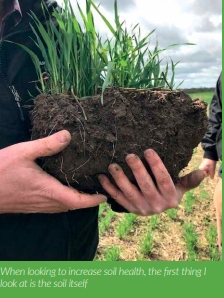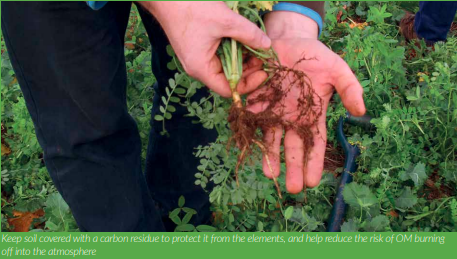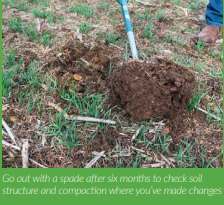Soil health is one of the government’s main concerns relating to the future of agriculture, and with many farmers
now turning towards conservation and biological farming, it is important to get soil heath, the cornerstone of these
principles, right.
George Hepburn, biological soils expert at QLF Agronomy, gives his six practical steps for improving soil health, no
matter what farming system.
Analysis
When looking to increase soil health, the first thing I look at is the soil itself. Go out with a spade, or in extreme cases a digger, and physically look at the soil. The presence of deep rooting systems, good soil aggregation and abundance of visible soil life are all key indicators of a healthy soil structure. To test this, look at how far rooting is going down and whether or not there are any fine hair roots. It’s also useful to smell the soil – healthy soil smells almost like dark chocolate, whereas anaerobic soils have an unpleasant smell.
Assess the aggregation of the soil to see if it’s crumbly or compacted, and check for soil life, such as millipedes, beetles and worms. You should see around 10 to 20 worms per spade in a healthy soil. It’s also useful to compare soil in the field with that from under the hedgerow, where soil health and structure won’t have been affected by cultivations or compaction.

Once you’ve assessed the look and feel of the soil, taking a soil test is the next step, because if you don’t measure it, you can’t manage it. However, it’s important to note that a standard UK test only provides N, P, K, Mg and pH measurements, which isn’t enough to accurately determine the level of soil health. I recommend a full spectrum test, which costs around £30 per sample. This will provide a more accurate picture of the soil make-up, by measuring calcium, boron and organic matter (OM) levels, pH, and the cation-exchange capacity (CEC) of your soil. It doesn’t really matter which lab you use, but once you have chosen one stick with it for consistency, as methods of analysis do vary. Once you’ve assessed the condition of your soil, you can then start to make changes.
Soil structure
Before you can affect the biology of the soil, the structure needs to be right. The soil micro flora and fauna need air to breathe, and food and water in the right proportions. The ideal soil structural makeup to provide this is 45% minerals, 5% OM, 25% air and 25% water. Calcium and magnesium are extremely important minerals as they help to define soil structure. Calcium deflocculates the soil, allowing air in and water out, and magnesium does the opposite, making the soil tight and sticky. Therefore, it’s essential to get this balance right. If there’s an imbalance you may need to apply gypsum (calcium sulphate) to help lower magnesium levels or apply calcium lime or magnesium lime. It may be the case that simple cultivation techniques such as subsoiling, ploughing or getting a tine in to aerate the soil, could be what you need to improve the structure.
Soil fertility plan
After creating the right conditions for the soil biology to thrive, you can now concentrate on providing the right inputs to make the soil more fertile. Traditional fertilisers, although necessary, generally do not improve the fertility of the soil itself. For example, as much as 40% of nitrogen can be lost to leaching, immobilisation by soil microbes, denitrification and volatilisation. This can leave you out of pocket due to wasted resources and can potentially reduce yields. Through experience, I would apply a new organically based input each year on each field to feed the soil. This could be FYM, compost, chopped straw, cover crops, lime, seaweed, gypsum, liquid carbon-based fertilisers or biologicals. These will all encourage the soil biology either by improving its habitat or directly feeding it.
Use quality inputs
When implementing a soil fertility plan, make sure you’re using the best fertiliser for your soil. This could simply mean switching from muriate of potash (MOP) to sulphate of potash (SOP), however there are also many other considerations when choosing inputs. We tend to focus on N, P and K but, although they are important, they’re a small part of the picture. Micro nutrients such as boron, zinc and manganese, are also important to soil fertility and include inputs that contain a range of nutrients can be much better for the soil, for example, Limex, P grow.

Ensure you’re using the right type of Nitrogen for your crop, establish if there is enough sulphur or phosphate, if the phosphate reserves are available to the plant and most importantly if you’re getting the most out of your applied fertiliser. There are a wide range of phosphate sources available, for example TSP is the most popular but the poorest efficiency of around 20%. Ironically some of the most efficient sources such as sewage sludge, fibrophos, FYM and digestate, are some of the cheapest. The added value of including organic sources of P, is that they also contain a mixture of other nutrients, such as sulphur and trace elements. Using a liquid carbon-based fertiliser, such as L-CBF BOOST™, can improve uptake efficiencies by stimulating the soil biology and providing an energy source which aids the breakdown of nutrients into a more readily available format for the plant.
Carbon
Although nitrogen is essential for plant growth, don’t overlook carbon, and especially the carbon to nitrogen ratio. This is vital because when the carbon to nitrogen ratio isn’t balanced and high nitrogen inputs or amendments are used, microbes then feed on the soil organic matter for their carbon, respiring carbon dioxide back into the atmosphere, depleting carbon and causing long term soil fertility and environmental problems. Including a carbon source with any applied nutrient will help to stabilise and buffer the nutrient.
This is because the carbon binds to the nutrients, chelating and complexing them, which improves plant uptake. Applying a carbon source such as carbon-based liquid fertiliser, L-CBF BOOST™, seaweed extracts, organic acids, compost teas, compost or manure, can improve nutrient cycling and reduce losses, meaning you’re getting the most out of the input. Wherever you can, keep the soil covered with a carbon residue to protect the soil from the elements, and help reduce the risk of OM burning off into the atmosphere. This can be achieved with cover and companion crops.

Evaluate
Finally, evaluation is crucial. Testing the soil and the plant itself will help you to determine if your work has been successful. Tissue testing can give an indication of the uptake of nutrients by the plant and help to determine if any additional remedial work and fertiliser applications have been effective. This is even more important on land where you’ve cut back on nutrients. Take the first test when crops begin to grow in spring and repeat on a fieldby-field basis two to three times per growing season, as a deficiency in just one trace mineral could limit yields. If deficiencies are seen, consider foliar applications of micro and macro nutrients to address this. After six months, go out with a spade to check soil structure and compaction where you’ve made changes. Analyse the results of soil samples and tissue tests and continue to take them regularly. Yield is important, but what we should be aiming for is long-term soil fertility so that we can continue to use the land for generations to come. For more information on improving your soil health contact George at george@qlf.co.uk.

